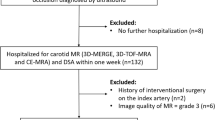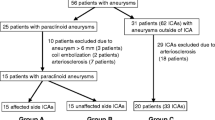Abstract
Background
This preliminary study was undertaken to evaluate relationship among the degree of internal carotid artery (ICA) stenosis, wall shear stress (WSS) by computational fluid dynamics (CFD) on magnetic resonance angiography (MRA) and 18F-FDG uptake of ICA on PET/CT.
Methods
A total of 40 carotid arteries in 20 patients with carotid atherosclerotic disease were examined with MRA and 18F-FDG PET/CT. Atherosclerotic risk factors were assessed in all patients. Degree of ICA stenosis was calculated according to NASCET method. CFD analysis was performed and maximum WSS (WSSmax) was measured. 18F-FDG uptake in ICA was quantified using maximum target-to-blood pool ratio (TBRmax).
Results
Atherosclerotic risk factors did not affect imaging findings. There were significant correlations between WSSmax and degree of ICA stenosis (ρ = .81, P < .001), WSSmax and TBRmax (ρ = .64, P < .001), and TBRmax and degree of ICA stenosis (ρ = .50, P = .001).
Conclusions
These preliminary results indicate that there may be significant correlations among the degree of ICA stenosis, WSSmax and TBRmax in patients with carotid artery stenosis.




Similar content being viewed by others
Abbreviations
- ICA:
-
Internal carotid artery
- MRI:
-
Magnetic resonance imaging
- PET:
-
Positron emission tomography
- FDG:
-
Fluorodeoxyglucose
- WSS:
-
Wall shear stress
- CFD:
-
Computational fluid dynamics
- MRA:
-
Magnetic resonance angiography
- BMI:
-
Body mass index
- SUV:
-
Standardized uptake value
- ROI:
-
Region of interest
- SUVmax:
-
Maximum standardized uptake value
- TBRmax:
-
Maximum target-to-blood pool ratio
- TOF:
-
Time-of-flight
- MIP:
-
Maximum intensity projection
- NASCET:
-
North American Symptomatic Carotid Endarterectomy Trial
- WSSmax:
-
Maximum wall shear stress
References
Barrett KM, Brott TG. Stroke caused by extracranial disease. Circ Res 2017;120:496-501.
Barnett HJ, Taylor DW, Eliasziw M, Fox AJ, Ferguson GG, Haynes RB, et al. Benefit of carotid endarterectomy in patients with symptomatic moderate or severe stenosis. North American Symptomatic Carotid Endarterectomy Trial Collaborators. N Engl J Med 1998;339:1415-25.
Rothwell PM, Gutnikov SA, Warlow CP. Reanalysis of the final results of the European Carotid Surgery Trial. Stroke 2003;34:514-23.
Millon A, Mathevet JL, Boussel L, Faries PL, Fayad ZA, Douek PC, et al. High-resolution magnetic resonance imaging of carotid atherosclerosis identifies vulnerable carotid plaques. J Vasc Surg 2013;57:1046-51.
Puppini G, Furlan F, Cirota N, Veraldi G, Piubello Q, Montemezzi S, et al. Characterisation of carotid atherosclerotic plaque: Comparison between magnetic resonance imaging and histology. Radiol Med 2006;111:921-30.
Takaya N, Yuan C, Chu B, Saam T, Underhill H, Cai J, et al. Association between carotid plaque characteristics and subsequent ischemic cerebrovascular events: A prospective assessment with MRI—initial results. Stroke 2006;37:818-23.
Zavodni AE, Wasserman BA, McClelland RL, Gomes AS, Folsom AR, Polak JF, et al. Carotid artery plaque morphology and composition in relation to incident cardiovascular events: The Multi-Ethnic Study of Atherosclerosis (MESA). Radiology 2014;271:381-9.
Sun J, Zhao XQ, Balu N, Neradilek MB, Isquith DA, Yamada K, et al. Carotid plaque lipid content and fibrous cap status predict systemic cardiovascular outcomes: The MRI substudy in AIM-HIGH. JACC Cardiovasc Imaging 2017;10:241-9.
McKenney-Drake ML, Moghbel MC, Paydary K, Alloosh M, Houshmand S, Moe S, et al. 18NaF and 18FDG as molecular probes in the evaluation of atherosclerosis. Eur J Nucl Med Mol Imaging 2018;45:2190-200.
Libby P. Inflammation in atherosclerosis. Nature 2002;420:868-74.
Tawakol A, Migrino RQ, Bashian GG, Bedri S, Vermylen D, Cury RC, et al. In vivo 18F-fluorodeoxyglucose positron emission tomography imaging provides a noninvasive measure of carotid plaque inflammation in patients. J Am Coll Cardiol 2006;48:1818-24.
Marnane M, Merwick A, Sheehan OC, Hannon N, Foran P, Grant T, et al. Carotid plaque inflammation on 18F-fluorodeoxyglucose positron emission tomography predicts early stroke recurrence. Ann Neurol 2012;71:709-18.
Gharahi H, Zambrano BA, Zhu DC, DeMarco JK, Baek S. Computational fluid dynamic simulation of human carotid artery bifurcation based on anatomy and volumetric blood flow rate measured with magnetic resonance imaging. Int J Adv Eng Sci Appl Math 2016;8:40-60.
Cicha I, Wörner A, Urschel K, Beronov K, Goppelt-Struebe M, Verhoeven E, et al. Carotid plaque vulnerability: A positive feedback between hemodynamic and biochemical mechanisms. Stroke 2011;42:3502-10.
Tuenter A, Selwaness M, Arias Lorza A, Schuurbiers JCH, Speelman L, Cibis M, et al. High shear stress relates to intraplaque haemorrhage in asymptomatic carotid plaques. Atherosclerosis 2016;251:348-54.
Samady H, Eshtehardi P, McDaniel MC, Suo J, Dhawan SS, Maynard C, et al. Coronary artery wall shear stress is associated with progression and transformation of atherosclerotic plaque and arterial remodeling in patients with coronary artery disease. Circulation 2011;124:779-88.
Konishi T, Norikane T, Yamamoto Y, Fujimoto K, Takami Y, Mitamura K, et al. The potential relationship between 18F-FDG uptake and wall shear stress in a patient with carotid artery disease. J Nucl Cardiol 2020; [Epub ahead of print].
North American Symptomatic Carotid Endarterectomy Trial Collaborators. Beneficial effect of carotid endarterectomy in symptomatic patients with high-grade carotid stenosis. N Engl J Med 1991;325:445-53.
Zarins CK, Zatina MA, Giddens DP, Ku DN, Glagov S. Shear stress regulation of artery lumen diameter in experimental atherogenesis. J Vasc Surg 1987;5:413-20.
Murray CD. The physiological principle of minimum work: A reply. J Gen Physiol 1931;14:445.
Font MA, Fernandez A, Carvajal A, Gamez C, Badimon L, Slevin M, et al. Imaging of early inflammation in low-to-moderate carotid stenosis by 18-FDG-PET. Front Biosci (Landmark Ed) 2009;14:3352-60.
Taqueti VR, Di Carli MF, Jerosch-Herold M, Sukhova GK, Murthy VL, Folco EJ, et al. Increased microvascularization and vessel permeability associate with active inflammation in human atheromata. Circ Cardiovasc Imaging 2014;7:920-9.
Honda A, Tahara N, Nitta Y, Tahara A, Igata S, Bekki M, et al. Vascular inflammation evaluated by [18F]-fluorodeoxyglucose-positron emission tomography/computed tomography is associated with endothelial dysfunction. Arterioscler Thromb Vasc Biol 2016;36:1980--8.
Figueroa AL, Subramanian SS, Cury RC, Truong QA, Gardecki JA, Tearney GJ, et al. Distribution of inflammation within carotid atherosclerotic plaques with high-risk morphological features: A comparison between positron emission tomography activity, plaque morphology, and histopathology. Circ Cardiovasc Imaging 2012;5:69--77.
Reeps C, Essler M, Pelisek J, Seidl S, Eckstein HH, Krause BJ. Increased 18F-fluorodeoxyglucose uptake in abdominal aortic aneurysms in positron emission/computed tomography is associated with inflammation, aortic wall instability, and acute symptoms. J Vasc Surg 2008;48:417-23.
Vesey AT, Jenkins WS, Irkle A, Moss A, Sng G, Forsythe RO, et al. 18F-fluoride and 18F-fluorodeoxyglucose positron emission tomography after transient ischemic attack or minor ischemic stroke: Case-control study. Circ Cardiovasc Imaging 2017;10:e004976.
Pan S. Molecular mechanisms responsible for the atheroprotective effects of laminar shear stress. Antioxid Redox Signal 2009;11:1669-82.
Dolan JM, Meng H, Singh S, Paluch R, Kolega J. High fluid shear stress and spatial shear stress gradients affect endothelial proliferation, survival, and alignment. Ann Biomed Eng 2011;39:1620--31.
Giannopoulos AA, Antoniadis AP, Croce K, Chatzizisis YS. Erosion of thin-cap fibroatheroma in an area of low endothelial shear stress: Anatomy and local hemodynamic environment dictate outcomes. JACC Cardiovasc Interv 2016;9:e77-8.
Xu XY, Borghi A, Nchimi A, Leung J, Gomez P, Cheng Z, et al. High levels of 18F-FDG uptake in aortic aneurysm wall are associated with high wall stress. Eur J Vasc Endovasc Surg 2010;39:295-301.
Jia Q, Liu H, Li Y, Wang X, Jia J, Li Y. Combination of magnetic resonance angiography and computational fluid dynamics may predict the risk of stroke in patients with asymptomatic carotid plaques. Med Sci Monit 2017;23:479-88.
Peng C, Wang X, **an Z, Liu X, Huang W, Xu P, et al. The impact of the geometric characteristics on the hemodynamics in the stenotic coronary artery. PLoS ONE 2016;11:e0157490.
Schirmer CM, Malek AM. Computational fluid dynamic characterization of carotid bifurcation stenosis in patient-based geometries. Brain Behav 2012;2:42-52.
Li CH, Gao BL, Wang JW, Liu JF, Li H, Yang ST. Hemodynamic factors affecting carotid sinus atherosclerotic stenosis. World Neurosurg 2019;121:e262-76.
Bhatia R, Vashisth S, Saini R. Wall shear stress analysis in stenosed carotid arteries with different shapes of plaque. Intl J Comput Appl 2016;145:9-12.
Shaikh S, Welch A, Ramalingam SL, Murray A, Wilson HM, McKiddie F, et al. Comparison of fluorodeoxyglucose uptake in symptomatic carotid artery and stable femoral artery plaques. Br J Surg 2014;101:363-70.
Elhfnawy AM, Heuschmann PU, Pham M, Volkmann J, Fluri F. Stenosis length and degree interact with the risk of cerebrovascular events related to internal carotid artery stenosis. Front Neurol 2019;10:317.
Lee JM, Choi G, Koo BK, Hwang D, Park J, Zhang J, et al. Identification of high-risk plaques destined to cause acute coronary syndrome using coronary computed tomographic angiography and computational fluid dynamics. JACC Cardiovasc Imaging 2019;12:1032-43.
Evans NR, Tarkin JM, Chowdhury MM, Le EPV, Coughlin PA, Rudd JHF, et al. Dual-tracer positron-emission tomography for identification of culprit carotid plaques and pathophysiology in vivo. Circ Cardiovasc Imaging 2020;13:e009539.
Eshtehardi P, Brown AJ, Bhargava A, et al. High wall shear stress and high-risk plaque: An emerging concept. Int J Cardiovasc Imaging 2017;33:1089-99.
Tahara N, Kai H, Ishibashi M, Nakaura H, Kaida H, Baba K, et al. Simvastatin attenuates plaque inflammation: Evaluation by fluorodeoxyglucose positron emission tomography. J Am Coll Cardiol 2006;48:1825-31.
Kimura H, Hayashi K, Taniguchi M, Hosoda K, Fujita A, Seta T, et al. Detection of hemodynamic characteristics before growth in growing cerebral aneurysms by analyzing time-of-flight magnetic resonance angiography images alone: Preliminary results. World Neurosurg 2019;122:e1439-48.
Disclosure
All authors declare that they have no conflicts of interest concerning this research.
Ethical approval
All study procedures were in accordance with the ethical standards of the institutional and/or national research committees and with the 1964 Helsinki declaration and its later amendments.
Author information
Authors and Affiliations
Corresponding author
Additional information
Publisher's Note
Springer Nature remains neutral with regard to jurisdictional claims in published maps and institutional affiliations.
The authors of this article have provided a PowerPoint file, available for download at SpringerLink, which summarises the contents of the paper and is free for re-use at meetings and presentations. Search for the article DOI on SpringerLink.com.
All editorial decisions for this article, including selection of reviewers and the final decision, were made by guest editor Robert deKemp, PhD.
Electronic supplementary material
Below is the link to the electronic supplementary material.
Rights and permissions
About this article
Cite this article
Takami, Y., Norikane, T., Yamamoto, Y. et al. A preliminary study of relationship among the degree of internal carotid artery stenosis, wall shear stress on MR angiography and 18F-FDG uptake on PET/CT. J. Nucl. Cardiol. 29, 569–577 (2022). https://doi.org/10.1007/s12350-020-02300-3
Received:
Accepted:
Published:
Issue Date:
DOI: https://doi.org/10.1007/s12350-020-02300-3




